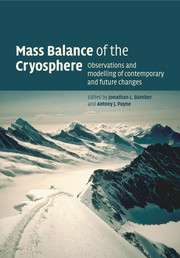Book contents
- Frontmatter
- Contents
- List of contributors
- Foreword
- Preface
- 1 Introduction and background
- Part I Observational techniques and methods
- Part II Modelling techniques and methods
- Part III The mass balance of sea ice
- Part IV The mass balance of the ice sheets
- 10 Greenland: recent mass balance observations
- 11 Greenland: modelling
- 12 Mass balance of the Antarctic ice sheet: observational aspects
- 13 Antarctica: modelling
- Part V The mass balance of ice caps and glaciers
- Index
- References
13 - Antarctica: modelling
Published online by Cambridge University Press: 16 October 2009
- Frontmatter
- Contents
- List of contributors
- Foreword
- Preface
- 1 Introduction and background
- Part I Observational techniques and methods
- Part II Modelling techniques and methods
- Part III The mass balance of sea ice
- Part IV The mass balance of the ice sheets
- 10 Greenland: recent mass balance observations
- 11 Greenland: modelling
- 12 Mass balance of the Antarctic ice sheet: observational aspects
- 13 Antarctica: modelling
- Part V The mass balance of ice caps and glaciers
- Index
- References
Summary
Introduction
Mathematical modelling represents a vital tool for understanding and predicting the current and future behaviour of the Antarctic ice sheet. Above all, modelling tries to overcome the limitations of space and time associated with making direct observations. The dynamical timescales associated with many components of the Antarctic ice sheet are far larger than the limited period for which measurements are available. Models also generate information over the entire ice sheet and can yield insight into many processes that are often inaccessible for direct observation such as at the ice-sheet base. In addition, models are the only tools we have at our disposal to forecast the future evolution of the ice sheet.
Today, the Antarctic ice sheet contains 89% of global ice volume, or enough ice to raise sea level by more than 60 m (Table 13.1). Hence, only a small fractional change of its volume would have a significant effect on the global environment. The average annual solid precipitation falling onto the ice sheet is equivalent to 5.1 mm of sea level, this input being approximately balanced by ice discharge into floating ice shelves, which experience melting and freezing at their underside and eventually break up to form icebergs.
Changes in ice discharge generally involve response times of the order of 102 to 104 years. These timescales are determined by isostasy, the ratio of ice thickness to yearly mass turnover, processes affecting ice viscosity and physical and thermal processes at the bed.
- Type
- Chapter
- Information
- Mass Balance of the CryosphereObservations and Modelling of Contemporary and Future Changes, pp. 491 - 524Publisher: Cambridge University PressPrint publication year: 2004
References
- 7
- Cited by

